We are going to take a tiny digression from Piers specific visualizations to get a sneak peak at visual data I’m presenting at the New Chaucer Society Congress in July.
What you are going to see here is a little different from the kind of data visualizations we’ve been looking at to date. So far, most of the data we’ve been highlighting here has been primarily data abstracted from a material phenomenon, and then reconfigured into slices meaningful to us. I’m going to talk more next week on what is “data,” so put a pin in those thoughts and we’ll come back to them.
 This week, we have a series of images of parchment surfaces (to be featured in NCS panel 5F on Parchment, organized by Bruce Holsinger) that have been translated via a few very intense scientific apparatuses into something that we think we understand intuitively. There is so much at work in that intuitive leap, however, that I think it’s worth breaking it down step by step.
This week, we have a series of images of parchment surfaces (to be featured in NCS panel 5F on Parchment, organized by Bruce Holsinger) that have been translated via a few very intense scientific apparatuses into something that we think we understand intuitively. There is so much at work in that intuitive leap, however, that I think it’s worth breaking it down step by step.
We start with a parchment sample. These have graciously been provided by Jesse Meyer of Pergamena. What we have below is a piece of calf that has been stretched but is not sanded or finished in anyway.  This is our material phenomenon, which, we should remember has already been extracted from its biological and ecological contexts before it arrives in this state. We are already making a determination that defines the limits of the phenomenon we hope to know something about. Karen Barad would call this an “agential cut,” or a distinction made by the observer to allow the phenomenon in question to be observed; it creates the phenomenon in the moment that it defines its boundaries. Before that moment, that cut by that observer, the phenomenon doesn’t exist. (For more on this, and how Barad arrives at it by reading Niels Bohr’s interpretation of quantum complementarity, see her book Meeting the Universe Halfway, or the shorter version in Stacy Alaimo and Susan Hekman’s collection Material Feminisms.)
This is our material phenomenon, which, we should remember has already been extracted from its biological and ecological contexts before it arrives in this state. We are already making a determination that defines the limits of the phenomenon we hope to know something about. Karen Barad would call this an “agential cut,” or a distinction made by the observer to allow the phenomenon in question to be observed; it creates the phenomenon in the moment that it defines its boundaries. Before that moment, that cut by that observer, the phenomenon doesn’t exist. (For more on this, and how Barad arrives at it by reading Niels Bohr’s interpretation of quantum complementarity, see her book Meeting the Universe Halfway, or the shorter version in Stacy Alaimo and Susan Hekman’s collection Material Feminisms.)
Making an agential cut, however, isn’t strictly a scientific process. It’s an interpretive process, one that we are all participating in all the time. It is the approximations that we must make in order to make sense of our universe. Alaimo, in Bodily Natures, discusses our transcorporeality, or our bodies’ co-extensiveness with our environments, how we are bleeding in and out of them (and they in and out of us) all the time. Where, really, do we end and our environments begin? You might say, “at our skin, of course!” but our skin itself is porous, with particles and substances traversing its membranes all the time. So, you might return, “well, fine, then how about at the molecular level? Surely there are molecules that belong to us and molecules that belong to our laptops or tables or whatever, and we can draw the line there.” And I would say that at the molecular level we’re basically all space and the bonds between atoms don’t tend to differ according to which body the atom belongs to. Indeed, in many instances, we actually, momentarily share chemical bonds with the surfaces we touch, with electrons traveling back and forth from us to table all the time (touching itself is a whole other issue that Barad has taken up, but we’ll discuss that elsewhere).
So, we can see that any time we define a body, we create it as a material phenomenon as well as an intellected phenomenon. Before we make the determination, it’s all just a mishmosh of atoms, or protons, neutrons and electrons, or we could zoom in farther still! Defining bodily boundaries slices the material “data” of the universe into comprehensible phenomena. We must remember that the slices are useful and necessary, but are never a perfectly accurate or complete representation of “reality,” because they are necessarily partial, flattened for visibility’s sake.
In the case of parchment, I mean literally flattened. I mean, think of the hundreds of processes that get compiled into a single piece of parchment. Not only do you have the animal itself (that supplied the skin), but you have the labor involved in transforming the skin. That labor is both human and non-human, incorporating the work of lye, wooden drums, stretching filaments, steel blades, and yes, human hands, backs, and bodies. But add onto that, the economic processes, the movements of all these goods–the lye, the steel, the wood, the skins; all of these commodities are themselves social, as Marx reminds us, and in the single product (parchment) all these movements and labors are materialized.
But further still, in the non-human components we have the congealing of all kinds of human and non-human processes and socialities. This parchment comes from a calf that is part of its own human-animal economy, that lives thanks to its biology, and that has been sustained up through its death by its ecology. In this calf we also have the cow’s flesh and milk converted into calf flesh. We have grass and feed converted into cow flesh as well. In the grass and feed we have the entire ecology of the soil, air, and sun that congeals in the processes of growth, respiration, and photosynthesis.
This parchment isn’t just a piece of parchment. But when we see it as parchment, when we define its boundaries, properties and components, we flatten all its other possibilities, its other realities, into something we recognize and understand. It becomes parchment by way of all these processes and agential cuts that make calves, skins, and its final product: parchment.
In order to transform this material phenomenon into “data” that is then legible in more specific and specialized ways, we have to make further cuts, further slices and organizations that rearrange the data into further comprehensible, interpretable, or computable forms.
In the above image, we have already started to organize the cuts we are going to make by labeling certain spots on the parchment with A, B, or C. 

 To then investigate this phenomenon further using even just a simple apparatus of a microscope objective and an imaging spectrograph (which for all intents and purposes in this kind of data does the work of an extremely high-powered camera), we have to further transform our material into a form suitable for experimentation–we have to turn our parchment into a sample.
To then investigate this phenomenon further using even just a simple apparatus of a microscope objective and an imaging spectrograph (which for all intents and purposes in this kind of data does the work of an extremely high-powered camera), we have to further transform our material into a form suitable for experimentation–we have to turn our parchment into a sample.
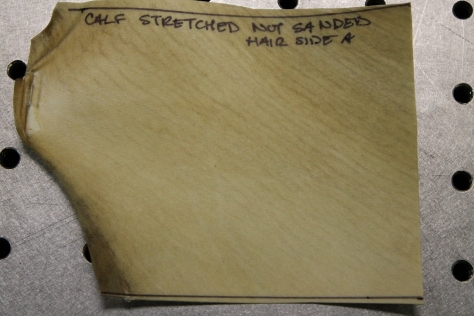
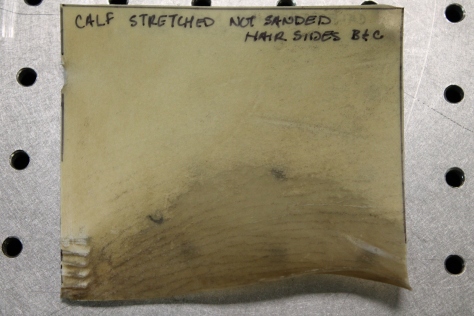

 A sample, however, is not simply a standardized form of the original phenomenon (though it is that too). It is a portion of the phenomenon selected for its specific characteristics. Selection itself is a process skewed towards the kind of information the observer hopes to obtain by running the experiment.
A sample, however, is not simply a standardized form of the original phenomenon (though it is that too). It is a portion of the phenomenon selected for its specific characteristics. Selection itself is a process skewed towards the kind of information the observer hopes to obtain by running the experiment.
In the case of the parchment surfaces experiment, I (the experimenter) care most about detecting quantitative distinctions between surfaces with qualitative differences. That is, I want to know if we can quantify the different feels of the various textures on parchment surfaces. So, when I select samples, they are not in any way representative of the whole, the majority, or the average. They are representative of significant differences themselves. That is, differences detectable by my eyes and fingers that seem to produce a qualitatively different experience of touching the parchment.
To become a sample, all of these significant differences have to be labelled, so that data can be collected from the specified sites. The differences marked here include:
- animal (calf, versus goat, sheep, deer or pig)
- finish (parchment versus leather)
- process (everything has been stretched, or it’s not parchment, but different samples have gone through various stages of finishing including sanding, re-stretching, and a final smoothing)
- side (flesh or hair)
- texture locale (in pieces that exhibited varying textures detectable by touch or sight, distinct textures were given letters to distinguish their data)
After samples have been created, we can begin to do what is properly called “data collection.” For this experiment, we are doing optical data collection, that is simply collecting the light that bounces off the sample the same way that our eyes do optical data collection. Except this time, our eyes are going to get a little extra help from a 2x microscope objective, the spectrograph photon detector, and the data collection software (Lightfield made by Princeton Instruments) that interprets all the information coming from the spectrograph and displays it on our screen. 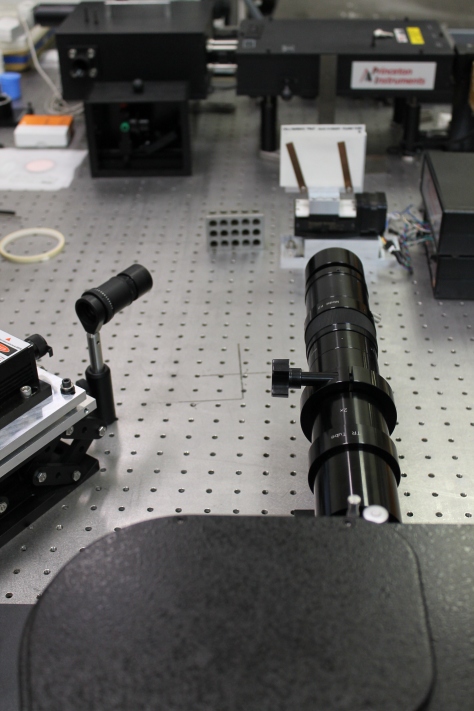
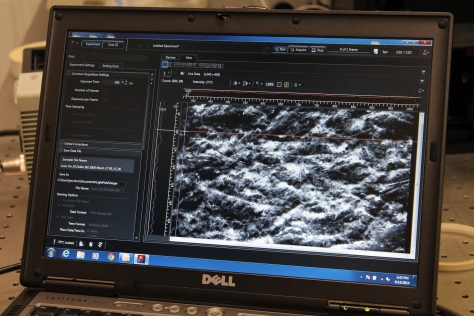 We set our samples up on the sample stage, and we use the laser to guarantee that we are collecting data from the differently designated textures:
We set our samples up on the sample stage, and we use the laser to guarantee that we are collecting data from the differently designated textures:
As we collect data, we further reduce the material “data” to a smaller and smaller sample. The optical data we collect from this image is roughly the size of a fingernail, and it often comes in like this: This is extremely hard to see, though, so we have to make further use of a prosthesis it interpret this by (artificially) increasing the contrast in the image itself.
This is extremely hard to see, though, so we have to make further use of a prosthesis it interpret this by (artificially) increasing the contrast in the image itself.  Neither of these images, though, are pictures in the sense in which we think of them. They don’t just transmit visual data about what is already there so that we can see it. They are data, constructed through an elaborate apparatus that translates information about a material object into a two-dimensional form that allows us to see what before we could only feel.
Neither of these images, though, are pictures in the sense in which we think of them. They don’t just transmit visual data about what is already there so that we can see it. They are data, constructed through an elaborate apparatus that translates information about a material object into a two-dimensional form that allows us to see what before we could only feel.
But even when this looks like a straightforward translation, we find it sometimes isn’t. If we return to the images collected for the piece of calf parchment we’ve already been investigating, you’ll see what I mean. The original images of location C (hair side first, then flesh) without contrast adjustment is this:
 Without contrast, it’s really hard to tell what kind of texture this is. It’s all sort of flattened out in a wash of grays, some of which are fuzzy. We can’t quite determine if they’re fuzzy because that’s telling us something about our sample, or because it’s out of focus for our apparatus. Even now we can’t trust that this image represents reality (especially since focus was achieved by adjusting the microscope objective by hand–by a fairly blind person, i.e. me). If we increase the contrast on these two images, which helped us above, we get this:
Without contrast, it’s really hard to tell what kind of texture this is. It’s all sort of flattened out in a wash of grays, some of which are fuzzy. We can’t quite determine if they’re fuzzy because that’s telling us something about our sample, or because it’s out of focus for our apparatus. Even now we can’t trust that this image represents reality (especially since focus was achieved by adjusting the microscope objective by hand–by a fairly blind person, i.e. me). If we increase the contrast on these two images, which helped us above, we get this:
 The contrast image of the hair side seems distinctly less helpful than that of the no contrast image, or the contrast image for the flesh side. In the flesh side contrast image, though, the region that seemed fuzzy or out of focus in the no contrast image becomes clear. It is in focus, and we can trust the data it returns to us. It just looks so fuzzy because the distinctions between the contours of this surface are much smaller than distinctions we can see elsewhere.
The contrast image of the hair side seems distinctly less helpful than that of the no contrast image, or the contrast image for the flesh side. In the flesh side contrast image, though, the region that seemed fuzzy or out of focus in the no contrast image becomes clear. It is in focus, and we can trust the data it returns to us. It just looks so fuzzy because the distinctions between the contours of this surface are much smaller than distinctions we can see elsewhere.
Every time we make a decision about how exactly to display our data so that it is easily interpretable, we make an agential cut that defines the object we are attempting to observe.
Now, what we really want to know, after making all these agential cuts, is do the surfaces at the different sample sites (on the same piece of parchment) yield different visual data? Well, let’s have a look at the other two samples, in their contrast images, and you can decide for yourself.
Here are the hair and flesh sides (respectively) of sample A:
And here are the images from sample B:
Now, whether or not these are interesting differences, I’ll leave for you to interpret. But let us not mistake the fact that they are easily interpretable to the non-expert who did not collect them, with the idea that they are direct and transparent translations of a simple reality. This is not “what parchment looks like,” but visual data about the texture of stretched but unfinished calf parchment. It is anything but straightforward.

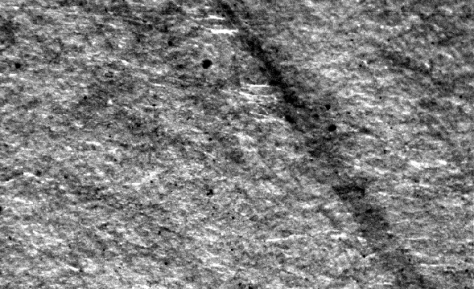


3 thoughts on “Making Parchment: Material Data and Agential Cuts”